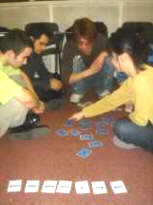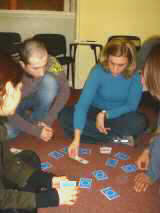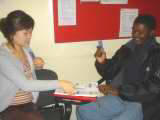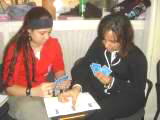|
by Jason Anderson |
Click on images to enlarge
Here is some feedback from students,
trainee EFL/ESL teachers and teacher trainers on the cards: "Thanks for your cards!
They are really good!" Laura (Teacher trainer, Uruguay) "I've started using the
pronunciation cards with one of my elementary classes and both the students
and I were positively thrilled! The students themselves have started coming
up with variants of popular local card games that can be adapted." Francesca (Teacher, Italy) "Jason's got a terrific imagination
, I could never have thought of all those awesome activities" Diego (Trainee teacher) "Please ask Jason whether he has any
more games to recommend!" Julieta (Trainee teacher) "Pronunciation lessons are
interesting with the cards. Before they were boring. My favourite game is 'Freeze'." Emre (Student, Turkey) |
|
Pronunciation Learning Cards are a practical resource to make the learning of the many vowel sounds in English fun! They should be useful to teachers of EFL (English as a Foreign Language) or ESOL whose learners are aiming towards a British English accent, and can be used in class with students of English from elementary to advanced levels. They have been developed to provide help with the difficult task of understanding, discriminating and internalising the 20 different vowel sounds in a standard UK accent. Whilst this set is orientated towards standard British English, they could be adapted for use in US English, Australian English, or any of the many beautiful Englishes of the world. I have created this web page to enable other teachers to download Pronunciation Learning Cards for use in their own classes. Everything on this page is free, but also copyrighted by myself. Hopefully, they make learning one aspect of pronunciation enjoyable, communicative and motivating. I have certainly found so myself since I started developing them. Please let me know how useful you find them, and if
you have any suggestions for improving them or games that I haven't included
on the instructions. My email address is below. I am a teacher of
English, teacher trainer and writer of English language teaching
material. Email me at:
|
|
|
|
|
|
|
|
1 Print the cards A4 Paper:
(Recommended) To print the cards, go to File -> Print. On the
printing options, check that Acrobat Reader doesn't automatically scale the
pages down, as this would make the cards a little smaller. Look for a
Page Scaling box, and select or tick 'None' in this box. Also check
that Acrobat Reader knows that your printer paper is A4. You can check
and change this if necessary by going to the Properties of the printer, and
selecting A4 paper. Letter Paper: To
print the cards onto letter-size paper, go to File -> Print and find the
Page Scaling box. Select 'Shrink Large Pages', or, on some versions of
Acrobat Reader, make sure there are no boxes ticked that prevent the program
from shrinking the pages down to letter size. If possible preview the
result before printing. |
|
|
2 Make sure they're not see-through You should print them out onto good quality paper,
and print or photocopy something onto the back of them to ensure that they
are not see-through. I have created a 'back' for them, (page 12 of the
downloadable pdf file). If you can afford to
keep them in colour, it makes them look more fun in
class. Just print p.12 onto the reverse side of all 11 card pages,
making sure the cards align on front and back. If you want to go for
the cheaper option, print p.12 once, and photocopy it onto the reverse of the
card pages, getting the alignment right before you start.
Alternatively, for a really cheap, quick option, just photocopy blackness (by
leaving the photocopier open while you're copying!) onto the back of the
cards, or double laminate the cards with coloured
paper (although this makes them quite bulky and could cause them to unstick after some wear and tear (see tip below about
this). |
|
|
3 Laminate & cut up the cards Once you've got the cards printed, and checked that
they are not going to be see-through, you need to laminate them. It's
easier and quicker to do this before you cut them up. Standard
laminating pouches are fine, but the thinner the laminate, the better, as
this makes the cards less bulky. After lamination, cut up the cards, and they're
ready to use. 4 Wear & Tear If your cards become unstuck at the corners due to
wear and tear, just run them through the laminating machine again. |
My Publications I
have written two photocopiable resource books for teachers, both published by
DELTA Publishing: ·
Teamwork – Interactive tasks to get
students talking ·
Role Plays for Today Both
are widely available (e.g. on Amazon) |
|
|







